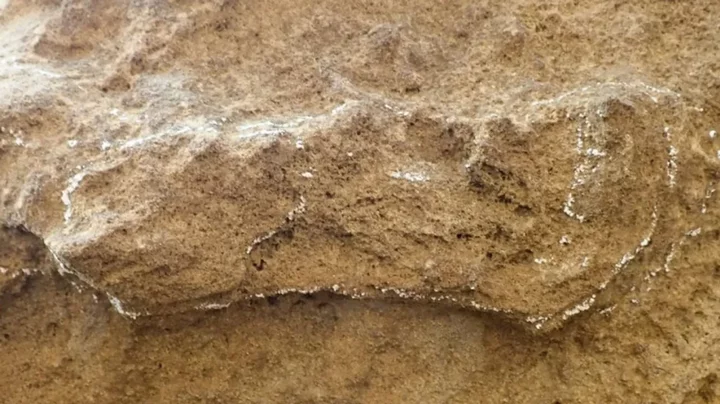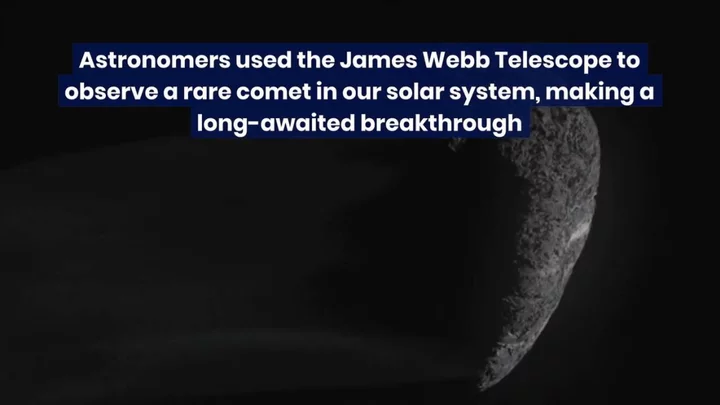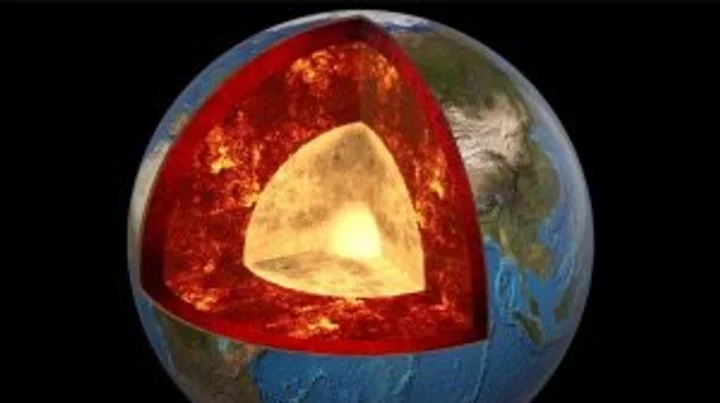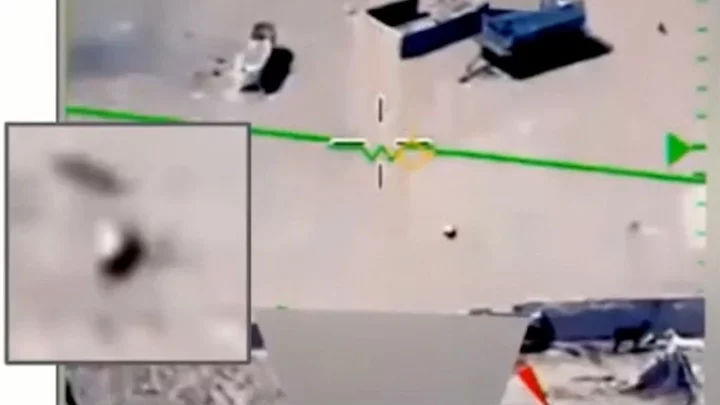
Scientists think there could be an 'anti-universe’ where time runs backwards
It sounds like something straight out of a Christopher Nolan film, but scientists have suggested that there could actually be an 'anti-universe' where time runs backwards. And if you’re anything like us, your brain is probably starting to hurt already. It comes from experts studying symmetries, and the new research is all to do with the fundamentals of symmetry in nature – the most significant of which are charge, parity and time. Bear with us… According to LiveScience, a new paper recently accepted for publication in the journal Annals of Physics suggests that there is a combined symmetry to the entire universe. Sign up to our new free Indy100 weekly newsletter As the research attests, the early universe was so uniform that time looks symmetric going backwards and forwards. The paper argues that the way we understand the world and wider universe around us, moving forwards in time, must also be expanded to include a mirrored version which runs backwards in time. It could also provide a deeper understanding of dark matter, too. The theory suggests that it is an invisible particle which only interacts via gravity and provides a pairing to the electron-neutrino, muon-neutrino and tau-neutrino. The research suggests that the conditions in a mirrored universe where time runs backwards would be full of these paired neutrinos, which would account for dark matter. Of course, we’d never be able to experience time running backwards even if it did definitely exist, but it’s a pretty cool theory none-the-less. It comes after Elon Musk made headlines in the world of science and space travel, after giving his estimation for when humans will land on Mars for the first time. The first moon landing famously took place in 1969, but space enthusiasts have been debating when they think the first Mars landing will be – now, the SpaceX CEO thinks we’ll be up there by 2029. Have your say in our news democracy. Click the upvote icon at the top of the page to help raise this article through the indy100 rankings.
2023-06-19 00:29

Scientists have worked out the most common days of the week for heart attacks
Research has been revealed that shows which day of the week heart attacks are most likely to take place. According to a new study, the most severe types of heart attacks are more common on Mondays than any other day. STEMI attacks are the most severe forms of attacks, which are caused by a blockage of the coronary artery and see an interruption to the blood supply. A total of 10,528 patients were analysed as part of new research, with the study focusing hospital cases in Ireland and Northern Ireland between 2013 and 2018. Sign up to our free Indy100 weekly newsletter The findings were presented at the British Cardiovascular Society (BCS) conference in Manchester. The data shows that the risk of an STEMI-type heart attack were 13 per cent greater on a Monday compared to the average of other days. Cardiologist Jack Laffan from the Belfast Health and Social Care Trust said at the conference: "We've found a strong statistical correlation between the start of the working week and the incidence of STEMI. This has been described before but remains a curiosity." Laffan also considers it likely that the natural cycle of weeks, months and seasons has on our health. He said: "Based on what we know from previous studies, it is reasonable to presume a circadian element". Nilesh Samani, medical director at the British Heart Foundation, added: "This study adds to evidence around the timing of particularly serious heart attacks, but we now need to unpick what it is about certain days of the week that makes them more likely. "Doing so could help doctors better understand this deadly condition so we can save more lives in future." It comes after a woman revealed how when she was a teenager she mistook a heart attack for butterflies, after dancing with a boy for the first time. Have your say in our news democracy. Click the upvote icon at the top of the page to help raise this article through the indy100 rankings.
2023-06-18 14:18

Study of oldest footprint ever may change the entire history of humanity
It’s not often that a single scientific discovery manages to change the way we think about the entire history of humanity. An ancient footprint has been newly uncovered, and it turns out that humans were walking around 30,000 years earlier than we previously thought. Two-legged homo sapiens were living in South Africa, it’s been proven, following the discovery of a 153,000 year old track. It was found in the Garden Route National Park near the coastal town of Knysna on the Cape South Coast. Sign up to our free Indy100 weekly newsletter The footmarks outdate the oldest previous discoveries, with the previous oldest found in nearby areas dated at 124,000 years old. The discoveries were made possible thanks to the optically-stimulated luminescence dating method, which analyses how long it’s been since a grain of sand has been exposed to sunlight. Researchers Charles Helm of Nelson Mandela University and the University of Leicester's Andrew Carr wrote in the Conversation: "In 2023, the situation is very different. It appears that people were not looking hard enough or were not looking in the right places. "Today, the African tally for dated hominin ichnosites (a term that includes both tracks and other traces) older than 50,000 years stands at 14. "Given that relatively few skeletal hominin remains have been found on the Cape coast, the traces left by our human ancestors as they moved about ancient landscapes are a useful way to complement and enhance our understanding of ancient hominins in Africa." The scientists involved believe that the area could be home to many illuminating discoveries given the makeup of the soil. They wrote: "We suspect that further hominin ichnosites are waiting to be discovered on the Cape South Coast and elsewhere on the coast. "The search also needs to be extended to older deposits in the region, ranging in age from 400,000 years to more than 2 million years. "A decade from now, we expect the list of ancient hominin ichnosites to be a lot longer than it is at present – and that scientists will be able to learn a great deal more about our ancient ancestors and the landscapes they occupied." Have your say in our news democracy. Click the upvote icon at the top of the page to help raise this article through the indy100 rankings.
2023-06-16 21:20

Mystery origin of Earth's water has finally been solved
Ever wondered how water first arrived on our planet? Well, it turns out the mystery could finally have been solved. Researchers have undertaken detailed analysis of asteroids and the findings could change the way the scientific community think about origins of water on our planet. Experts at the University of Arizona's Lunar and Planetary Laboratory (LPL) have discovered salt crystals on samples recovered from space. As their findings state, these crystals could only have formed with the presence of water. Sign up to our free Indy100 weekly newsletter The research was undertaken on samples of the asteroid Itokawa in 2005 by the Japanese Hayabusa mission. It suggests that S-type asteroids could be home to more water than previously thought. The new findings led some scientists to claim that water is likely to have arrived on asteroids when our planet was first being formed. The senior’s author Tom Zega said: "The grains look exactly like what you would see if you took table salt at home and placed it under an electron microscope. "They're these nice, square crystals. It was funny, too, because we had many spirited group meeting conversations about them, because it was just so unreal. Zega added: "It has long been thought that ordinary chondrites are an unlikely source of water on Earth. Our discovery of sodium chloride tells us this asteroid population could harbour much more water than we thought." Itokawa is a S-type asteroid, and it’s thought that temperatures on their surfaces were too high for water to form. Shaofan Che, who is the lead study author, said: "In other words, the water here on Earth had to be delivered from the outer reaches of the solar nebula, where temperatures were much colder and allowed water to exist, most likely in the form of ice. "The most likely scenario is that comets or another type of asteroid known as C-type asteroids, which resided farther out in the solar nebula, migrated inward and delivered their watery cargo by impacting the young Earth." Have your say in our news democracy. Click the upvote icon at the top of the page to help raise this article through the indy100 rankings.
2023-06-16 20:23

Richard Branson’s Virgin Galactic Sets June Date for First Commercial Spaceflight
Virgin Galactic Holdings Inc., Richard Branson’s space-tourism venture, surged after announcing that its long-awaited first commercial passenger mission
2023-06-16 19:55

Every glass of water you have drank contains dinosaur wee
Experts have explained the reason why every glass of water we consume has dinosaur urine in it and it's not as gross as it sounds. When you get a cold glass of water from the tap, chances are you don’t think much about it before getting it down the hatch, so long as it looks clean. But, water experts have explained that the water you’re drinking may have gone through a dinosaur or even through your neighbour, before getting to you. This is because every drop of water on Earth has gone through a continuous water cycle over billions of years, and the amount of water on the planet at any given time is always the same. Severn Trent Water explained more, telling the Birmingham Mail how our planet's water cycle works. Sign up to our free Indy100 weekly newsletter They explained: “ Heat energy from the sun causes water to evaporate into the atmosphere from sea, lakes and the soil. “Air currents containing water vapour rise over higher ground into cooler temperatures which causes condensation and creates clouds. “More air currents cause the clouds to move around the Earth, across sea and land. As the clouds cool, precipitation as snow, sleet, hail or rain.” They explained that the vast majority of precipitation on Earth ends up back in waterways, such as seas, lakes and rivers. Continuing, they revealed: “97 per cent of the world’s water is salty sea water, two per cent is frozen in the polar ice caps and one per cent is fresh water for us to use.” Water companies collect and store water in reservoirs, which is then treated and tested by the Environment Agency and Drinking Water Inspectorate. It can then be distributed to homes through pipes. Then, the wastewater that has been used is transported through drains and sewers to sewage treatment works and returned to streams and rivers. Have your say in our news democracy. Click the upvote icon at the top of the page to help raise this article through the indy100 rankings.
2023-06-15 23:53

Nasa astronaut claims that aliens have prevented a nuclear war on Earth
Could we have aliens to thank for preventing a nuclear war on Earth? That’s what one former Nasa astronaut has claimed. Edgar Mitchell, who was involved in the Apollo 14 mission, gained a reputation for sharing conspiracy theories when he arrived back from the moon in 1971. Mitchell was the sixth man on the moon and was the Lunar Module Pilot on Apollo 14. Before his death in 2016, Mitchell spoke at length claiming that aliens visited Earth. Speaking to the Mirror, he alleged that aliens were responsible for preventing nuclear war between the US and the Soviets at the height of Cold War tensions. Sign up to our free Indy100 weekly newsletter At the time, Mitchell focused on the White Sands Missile Range facility in New Mexico. “White Sands was a testing ground for atomic weapons – and that's what the extraterrestrials were interested in,” he said. "They wanted to know about our military capabilities. My own experience talking to people has made it clear the ETs had been attempting to keep us from going to war and help create peace on Earth." White Sands Missile Range is where the first atomic bomb was tested in 1945, and Mitchell claimed that officers there had told him aliens had shot down missiles flying over the site. The claims were, as you’d expect, disputed. UFO expert Nigel Watson told IFL Science at the time: "To me, this is just another case of UFO fantasy and speculation. When you try getting to the facts it is like trying to herd cats." Meanwhile, a UFO conspiracy theorist recently described the south pole as an “air traffic control” hub for aliens. A recent discussion centred on the Amundsen–Scott South Pole, which Eric Hecker claimed communicated with “exotic” crafts by sending neutrino rays up into space. Hecker went further by talking about “digital optical modules” buried a mile beneath the surface under the ice. He claims they were buried in order to detect neutrino interactions while being deep enough not to interfere with radiation readings. Have your say in our news democracy. Click the upvote icon at the top of the page to help raise this article through the indy100 rankings.
2023-06-15 23:21

France Gains Ground in Bid for Renewable Energy Carve-Out
France moved closer to securing a carve-out from the European Union’s plans to massively scale up renewable energy
2023-06-14 15:59

Two giant 'blobs' in Earth's core could be remains of an ancient planet
Many of us look to the stars for answers to life’s most complex questions. But actually, some of the greatest mysteries lie beneath our very feet. One might think we’d know the Earth pretty well by now but, in fact, our planet’s core remains shrouded in enigma. Indeed, there are two gigantic blobs located beneath Africa and the Pacific Ocean that occupy around six per cent of the world’s entire volume. And yet, we’re still not entirely sure what they’re made of or where they came from. There are a number of hypotheses, including that they are piles of oceanic crust that have accumulated over billions of years. Sign up for our free Indy100 weekly newsletter But a more interesting theory is that they are huge chunks of an ancient planet that hit the Earth around 4.5 billion years ago. To give an indication of just how massive these things are, the structure under Africa – an area known as Tuzo – is thought to be around 800km (497 miles) tall – the equivalent of some 90 Mount Everests stacked on top of one another, as IFLScience notes. The problem with determining the origin of these monster formations is that there are no direct ways of observing the Earth’s core. The deepest hole humans have ever dug – branded the "entrance to hell" – reached a pretty staggering 12,263m (40,230ft), but that doesn’t even come close to breaking through the crust to the layers beneath. Our most effective tool for analysing what lies beneath the ground is a technique called seismic tomography, which looks at how waves of energy travel when earthquakes occur. Since rocks and liquids have different densities, the waves move through them at different speeds. By measuring the tremors from different points on the surface, geologists can determine what kind of material the waves are travelling through and, in so doing, map out the Earth’s interior. It was by using this technique that the two unusual structures – known as large low shear velocity provinces (LLSVPs) – were found. Waves travel more slowly in these areas – fondly known as “blobs” – than through the surrounding lower mantle, indicating that they’re made of something different. We can’t tell what this material is based on seismic tomography data alone, but some scientists like to believe that they are the remnants of an ancient planet called Theia – an idea known as the “giant impact hypothesis”. According to this hypothesis, around 4.5 billion years ago, a Mars-sized object collided with the Earth. This impact not only created the planet we call home today, but also threw off enough rock to form the moon that lights up our night skies. Some scientists suggest that some of Theia’s leftovers also sunk to the bottom of the planet, probably settling somewhere above the core – thereby forming at least one of the two LLSVPs. More Updates About Strange Blob Structures Inside Planet Earth youtu.be Experts have been investigating the area for decades but there’s still no way of knowing for sure just what these two giant blobs are. Still, studies into Theia have offered important insights into how the possible collision might have kickstarted key plate tectonic and mantle motion inside our planet – crucial processes for establishing the world on which we live. It’s also a useful reminder that we still have so much to learn about our planet and where we came from. Have your say in our news democracy. Click the upvote icon at the top of the page to help raise this article through the indy100 rankings.
2023-06-14 15:17

8 Granular Facts About Sand
Every summer at the beach, sand becomes an essential ingredient in the recipe for fun. But what the heck is it?
2023-06-14 00:23

Animation goes viral for showing 'what happiness really looks like'
Happiness is one of life’s most elusive gifts – it is an emotion that can’t be pinned down. And yet, an animation showing a protein molecule “walking along”, carrying a large sphere, is widely credited with being a visual representation of joy itself. The gif has trended online for almost a decade but continues to breed delight in those who see it. Many people believe that it is – to use the technical terms – a myosin transporting endorphins in the brain. In other words, it is a scientific portrayal of the actual processes that give us that warm and fuzzy feeling. Sign up for our free Indy100 weekly newsletter However, though we’d hate to dampen the mood, this isn’t quite accurate. In fact, the real brain behind the original clip, medical artist John Liebler, set out the truth back in 2014. @mommyca713 AMAZING! #cells #innerlife #happiness #lookslike #facts #fact #fyi #fyp #brain #research #facts #animation #myosin #interesting #education #viral #fypシ #humanbrain #mentalhealth #science #stem He explained that he, his team at medical technology company XVIVO, and two Harvard University researchers created the 3D computer animation in 2006 for a biology classroom video called ‘The Inner Life of the Cell’, as Science Alert reports. The educational clip wasn't intended to depict a brain process at all but to take the viewer "on a journey through the microscopic world of a cell, illustrating mechanisms that allow a white blood cell to sense its surroundings and respond to an external stimulus,” according to Liebler himself. So this is all about a protein in a white blood cell, not a protein in a neuron. The Inner Life of the Cell Animation youtu.be At any rate, happiness doesn’t just come about through a single process. So even if the clip did show endorphins being delivered to our brains, this wouldn’t offer a full picture. Dopamine, other neurotransmitters (for example, serotonin), biological health and genetics all play a part in cementing our feelings of contentment. We don’t just rely on jolly little myosin proteins lugging around bundles of cheer. Still, the internet is now awash with jovial variations on the clip and it can’t be denied that the scene-stealing strutting protein is pretty damn cute. So if that’s enough to bring a smile to your face, maybe it is a representation of happiness after all. Have your say in our news democracy. Click the upvote icon at the top of the page to help raise this article through the indy100 rankings.
2023-06-13 18:19

Astronomers have finally figured out the source of the brightest explosion ever recorded
Astronomers believe they might have found the source of the brightest explosion ever in space. The record-breaking explosion recorded in October 2022 was the most powerful ever seen, leaving equipment and instruments struggling to measure it as it pointed directly at planet Earth. The bright gamma-ray burst is officially called GRB 221009A and when it first went off, scientists were left scrabbling to point telescopes in its direction to record it. The explosion has affectionately been nicknamed BOAT, standing for “brightest of all time”, and was caused by the death of a large star located 2.4 billion light-years away – relatively close in terms of space activity. The star collapsed into a black hole after ejecting its outer envelope, causing this huge, bright explosion comprised of gamma rays, producing not only a narrow structured jet but with an additional outflow of gas. Sign up to our free Indy100 weekly newsletter This “exceptionally rare event” surprised astronomers, who had not predicted the existence of gas, and certainly provides plenty of new information around the question of how black holes form. The study’s lead author and astronomer from George Washington University, Brendan O'Connor, explained: “GRB 221009A represents a massive step forward in our understanding of gamma-ray bursts, and demonstrates that the most extreme explosions do not obey the standard physics assumed for garden variety gamma-ray bursts.” He continued: “GRB 221009A might be the equivalent Rosetta stone of long GRBs, forcing us to revise our standard theories of how relativistic outflows are formed in collapsing massive stars.” The huge and long-lasting blast measured up to 18 teraelectronvolts which is a staggering record for a gamma-ray burst, leaving scientists to hypothesise that it was a supernova. Have your say in our news democracy. Click the upvote icon at the top of the page to help raise this article through the indy100 rankings.
2023-06-12 22:26
